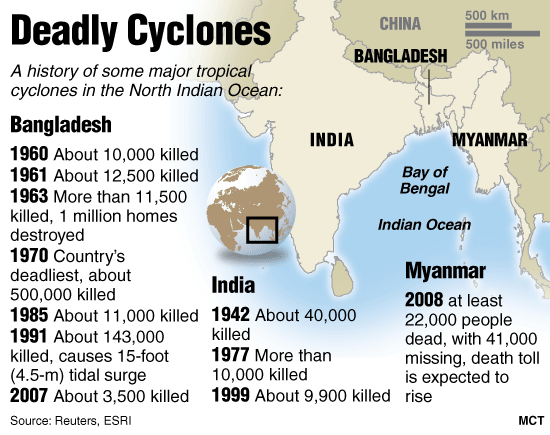
World News Desk
Learn the why behind the headlines.
Subscribe to the Real Truth for FREE news and analysis.
Subscribe NowCyclone Nargis, and the resulting tidal wave, has killed at least 62,000 people in the Southeast Asian nation of Myanmar, with 41,000 missing. The death toll is expected to rise as officials manage to contact remote areas.
The storm, which made landfall between 2 a.m. and 6 a.m. on May 3, ripped through the region with winds reaching 130 mph, destroying entire villages, bringing down power lines and uprooting trees.
Most deaths were caused by a 12-foot-high tidal wave that swept through the low-lying coastal region, and state-run television reported that 10,000 people had died in the town of Bogalay alone.
Nargis is the worst cyclone to strike the area since 1991, when 143,000 people were killed in Bangladesh.
With hundreds of thousands of people left homeless, the United Nations and Myanmar’s neighboring countries have begun providing food, water and shelter for survivors. In a nation that maintains tightly controlled borders, government officials said they would allow relief groups to enter the country, though foreigners and journalists are barred from entering.
Also, uprooted trees and other debris are blocking roads, slowing disaster response and increasing casualties.
A Yangon resident described conditions in an email: “No drinking water in many areas, still no power. Houses completely disappeared. Refugees scavenging for food in poorer areas. Roofing, building supplies, tools—all are scarce and prices skyrocketing on everything” (New York Times).
World Vision, a relief agency that has been working in Myanmar for decades, estimates that at least two million people will be in need of food, shelter and other assistance. The agency is appealing for millions of dollars in assistance to aid survivors.
Additionally, cyclone Nargis destroyed all crops in the main rice-growing region, home to half of the country’s population. In one of the poorest nations on earth, where 90% live on less than a dollar a day, the destruction of the rice harvest will make it more difficult for those in Myanmar to find basic necessities.
More on Related Topics:
- The Swarm of Earthquakes Shaking Santorini Prompts Greece to Declare an Emergency
- Nearly 250 Million Children Missed School Last Year Because of Extreme Weather, UNICEF Says
- What to Know About the Devastation from the Los Angeles-area Fires
- Los Angeles Wildfires Rage Out of Control, Testing Firefighting Resources
- A Quarter of Freshwater Animals Are Threatened with Extinction, New Research Shows


